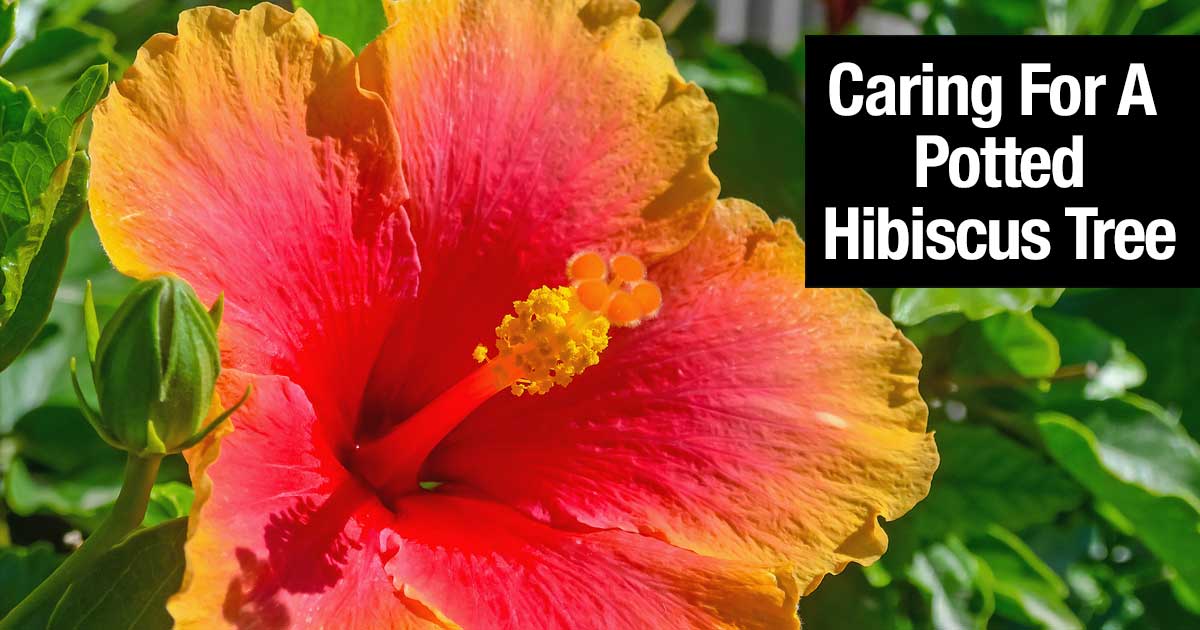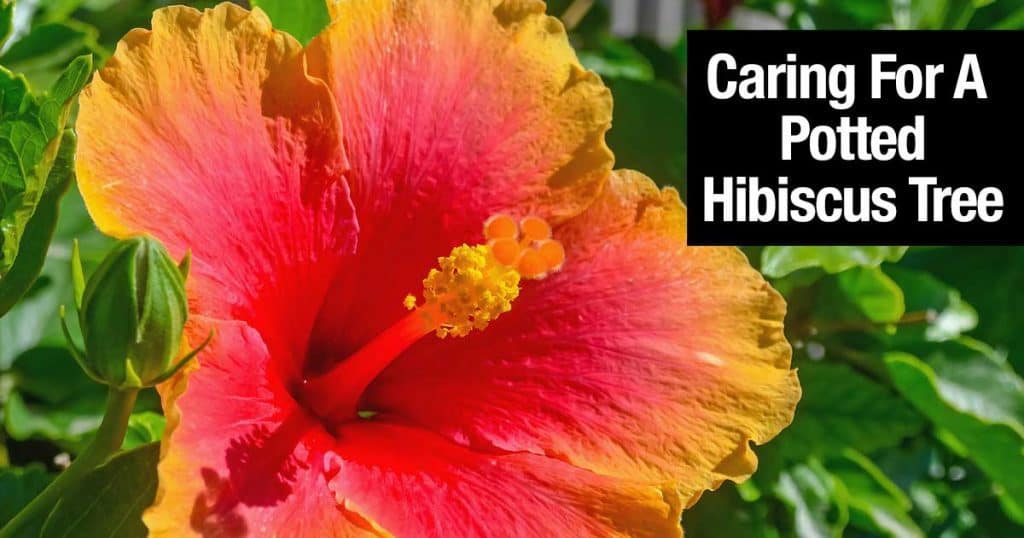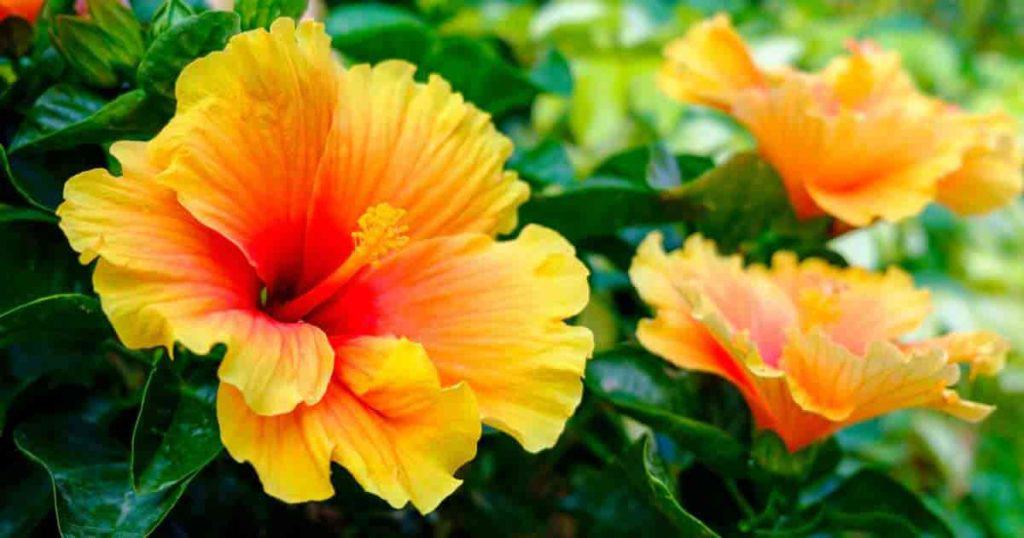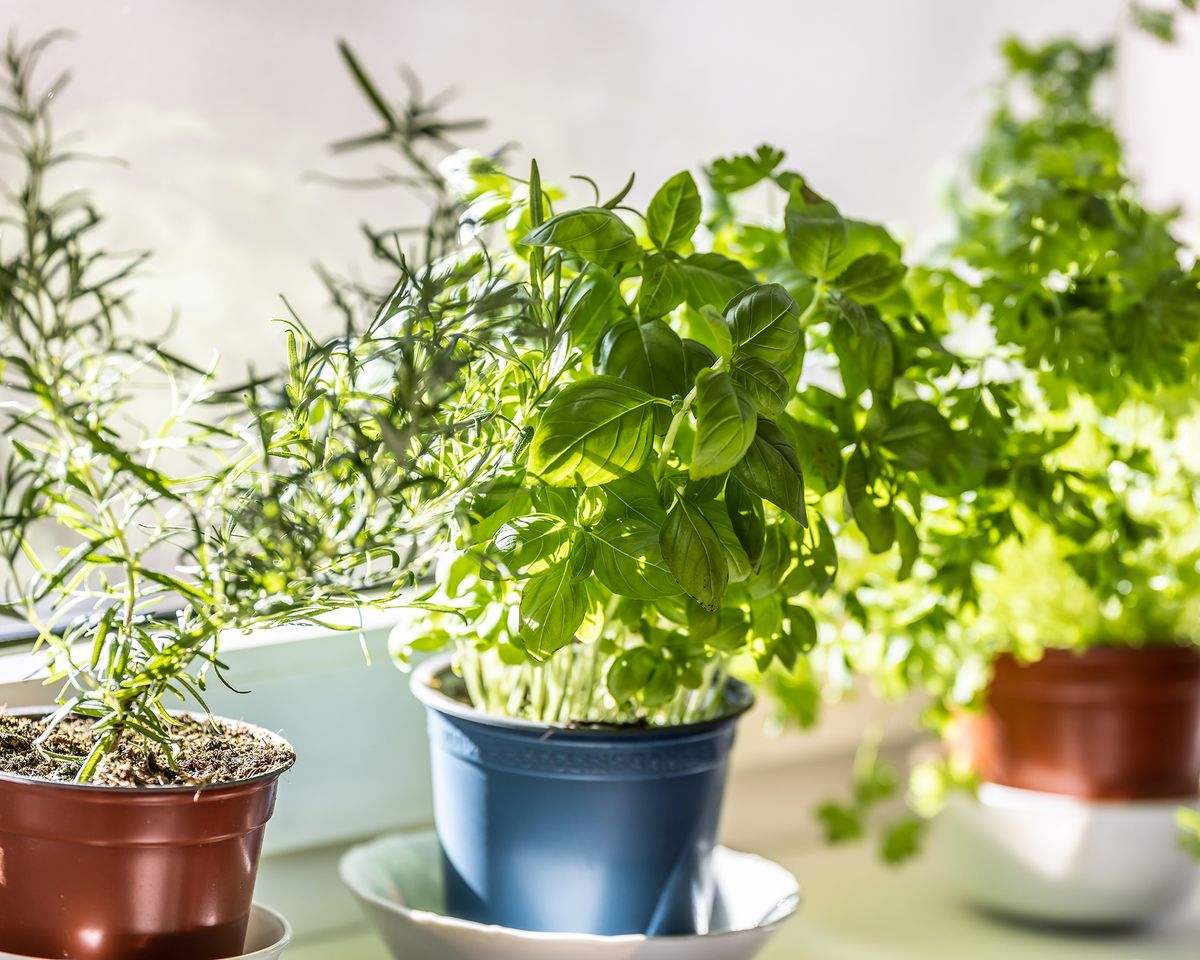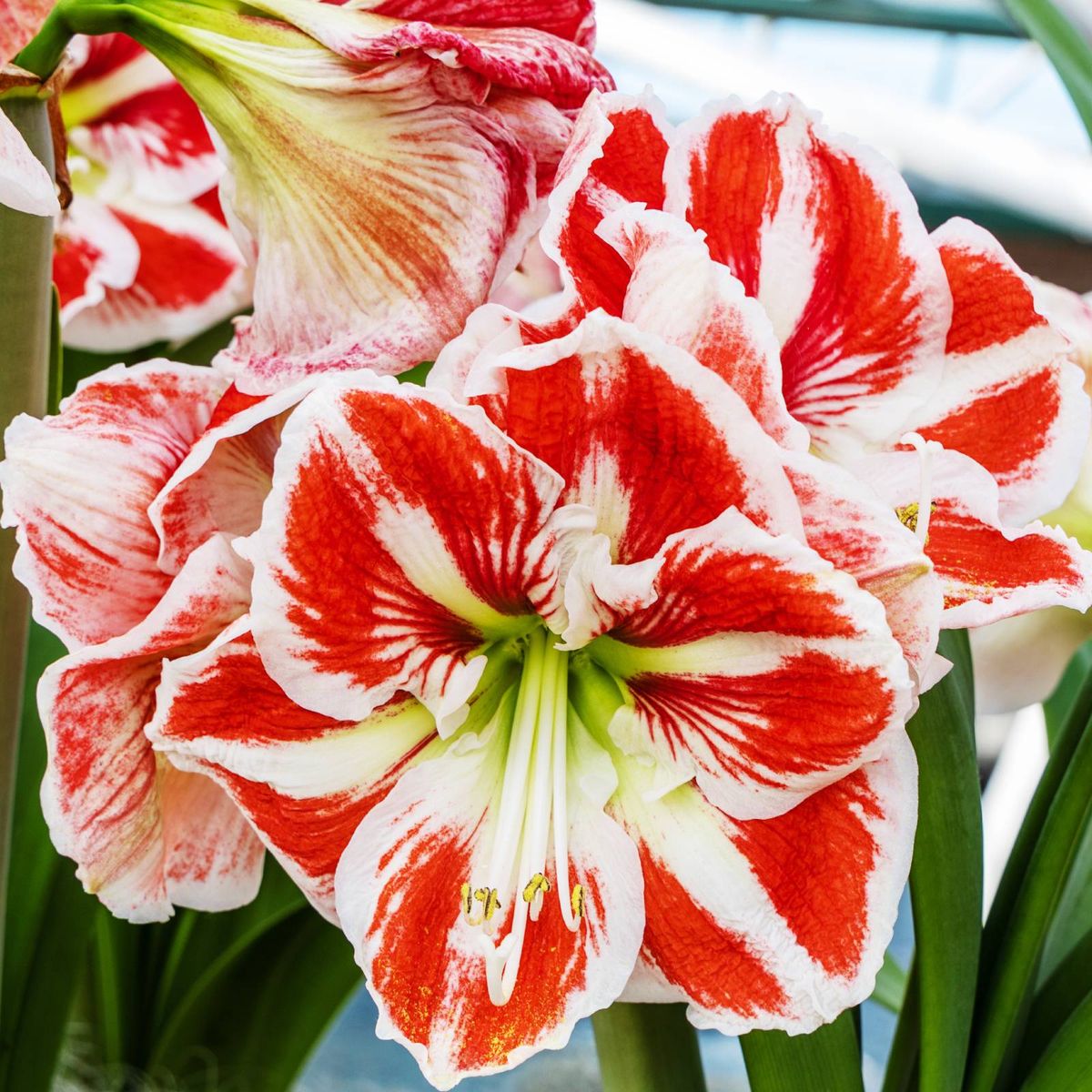The potted tropical hibiscus tree is a popular plant across the US in the springtime. Their red flower along with other colors finds a home on front porches, out on back patios and decks.
I like growing tropical Hibiscus plants as a tree. Read on for tips on how to care for these colorful flowered beauties.
Hibiscus plants [hi-BIS-kus] is an evergreen plant from the Mallow Family – Malvaceae.
They are a diverse group of plants with several hundred species found worldwide in warm, tropical climates.
The exact origin of Hibiscus is unknown. However, experts believe that different species have originated in China, Hawaii, India, and Madagascar.
The flowers of several hibiscus species represent nations. For example, Haiti lists the hibiscus as their national flower.
Hibiscus syriacus, the “Rose Of Sharon tree,” is South Korea’s national flower. Malaysia calls Hibiscus rosa-sinensis; the tropical Hibiscus is their national flower.
Tropical hibiscus trees are not exactly annual but can be grown as an annual in cooler climates. Chinese hibiscus is often grown in containers and comes in a variety of colors.
Growing Hibiscus Plants and Hibiscus Plant Care
Size and Growth
The leaves of tropical hibiscus trees have a darker green (often glossy) deeper foliage color.
Perennial hibiscus survives winter in zones 4 to 9. The perennials have lighter green leaves and bigger flowers. Leaf color and bloom size vary from species to species.
Tropical Hibiscus grows in sunny, warmer climates. In winter, bring them indoors. They survive outdoors only in USDA hardiness zones 10-12. In cooler climates, they grow well as container plants.
Potted hibiscus plants can grow up to 7′ – 8′ feet tall.
Flowering Hibiscus and Fragrance
Both perennial and tropical hibiscus have big, vibrant blooms. However, tropical Hibiscus blooms longer than perennial hibiscus.
Hibiscus flowers open daily and last for only one day, after which they die. This is normal! Remove all wilted or unsightly flowers.
The flower colors of tropical hibiscus plants come in pink, yellow, pink, orange, red, purple, white, or bi-color.
Perennial hardy hibiscus flower in mid-to-late summer. Its blooms come in various colors, like pink, red, white, pink, lavender, and burgundy. If your garden is small, look for dwarf varieties.
Most Hibiscus blooms have no noticeable scent or fragrance.
Hibiscus Plant Light Requirements
Hibiscus Plants Love Lots of Sunshine
Outdoor Hibiscus bloom well when plants get plenty of sunshine (full sun). Lots of direct sunlight helps hibiscus trees produce sturdy growth and colorful blooms. They can handle some afternoon shade.
Ensure good branching by pinching growing tips when plants are small.
The new growth will branch out into a desirable bush if the pinching is done just above an outside bud.
Hibiscus flowers are borne on the young wood, and heavy pruning is in order every year to develop plenty of new growth without the plant becoming too large when growing indoors.
Details: Tips On How Much Sun A Hibiscus Tree Needs
Hibiscus Tree Lighting Indoors
Indoor Hibiscus requires intense light to flower well. For best results, place your hibiscus in a sunny southern or western exposure with a minimum of 4 to 5 hours of direct light.
Whether indoors or outdoors, the more light your Hibiscus trees get, the better they bloom.
Growing Hibiscus Plants Under Grow Lights
Hibiscus thrive under fluorescent grow light culture. Grow Hibiscus by placing plants under fluorescent tubes. Make sure the top of the foliage does do not quite touch the tubes.
A fluorescent unit can be made of two 48″-watt tubes. Given much humidity and 12 to 15 hours of daily illumination, Hibiscus does well under the lights.
Hibiscus Temperature Range
Outdoor Temperatures For Hibiscus
As for temperature, Hibiscus are tropical plants and cannot survive cold temperatures. However, flower bud development requires warm temperatures.
Hibiscus plants will thrive outdoors where the night temperature doesn’t drop below 50° degrees Fahrenheit.
Indoor Temperatures For Hibiscus
When growing Hibiscus plants indoors, choose a sunny spot with daytime temperatures no lower than 55° degrees Fahrenheit. The ideal temperature range is 65° to 75°degrees Fahrenheit.
Hibiscus is sensitive to changes in humidity and temperature. So avoid placing them in draughty spots, on TVs, near radiators, or in entryways where cold air constantly blasts them.
Flower buds may drop off or fail to form entirely due to cold weather.
Watering Requirements and Fertilizing Hibiscus Trees
Quick Hibiscus Watering Tips
- Keep the soil moist, not saturated.
- Never let the potting soil dry out to the extent of wilting.
- Use a pot with drainage holes.
- Water at the soil surface to let the water run down and out. This leaches soluble salts from the soil while watering bottom roots well.
- Remove any excess water.
- Allow the soil to dry out some between waterings throughout winter.
A growing Hibiscus outdoors is a thirsty plant and needs to be well watered. Water Hibiscus plants at least 3 to 4 times a week to keep the soil and the plant’s root ball moist.
When watering plants indoors, keep the soil moist but not wet.
Avoid overwatering or allowing your plant to sit with “wet feet.” Instead, prevent root rot by letting plants drain completely after watering. Always use a pot with drainage holes.
Avoid watering Hibiscus with cold water, especially during winter months.
This tropical plant prefers water around 95° degrees Fahrenheit. Always check the water temperature with your hand to ensure it is not too hot and never too cold.
Liquid Fertilizer or Slow-Release Fertilizer
The colorful flowers of Hibiscus make them demanding feeders, requiring balanced fertilizers.
- For liquid fertilizer, we recommend 20-20-20 or 10-10-10 at half strength.
- For granular applications, apply a Hibiscus fertilizer once a month during the spring/summer growing season.
A Hibiscus growing outdoors during the hot summer uses significant amounts of water. As a result, plants may need watering every day.
This free use of water leaches out plant food in the soil. Therefore, when fertilizing with liquid plant food, feeding every week is necessary.
A plant fertilizer with too much nitrogen will produce lots of foliage and not enough flowers.
A well-balanced food or special Hibiscus fertilizer help plants produce large, colorful flowers.
When growing the Hibiscus plant indoors, fertilize less often. Feed at half-strength once a month in spring and summer and every two months in winter.
If you click this link and make a purchase, we earn a commission at no additional cost to you.
NOTE: Trace elements such as iron and magnesium also help a growing hibiscus thrive.
Soil, Repotting, or Transplanting
Hibiscus plants are not particular about soil or potting mix. But a humusy, rich, moist soil and well-drained soil will produce healthy roots and plenty of attractive Hibiscus flowers.
Here is a well-drained soil recipe for Hibiscus indoors:
- Two parts potting soil
- 1 part perlite or vermiculite
- Two parts peat moss
Here is a soil mix recipe for outdoor plants:
- 1 part garden loam
- 1 part Canadian peat moss
- 1 part fine bark and sand
Transplanting:
Transplanting To A Larger Pot
- When transplanting, remove any weak, sick-looking, or ailing roots from the root ball.
- Step up to the next size larger pot with a drainage hole
- Place soil in the bottom of the pot
- Place plant in the pot
- Fill in open space with fresh new moist soil
- Water and saturate the soil.
Repotting In the Same Pot
- Remove the plant from the existing pot
- Remove 1/3 of the leaves and stems.
- Remove 1/3 no more of the root ball
- Place fresh soil in the bottom of the pot
- Place plant in the pot
- Fill in open space with fresh new moist soil
- Water and saturate the soil.
Grooming and Pruning
Hibiscus does not require lots of grooming other than removing old spent blooms. But they do require some pruning.
Pruning will encourage more flower production and maintain the plants’ shape.
To keep a healthy-looking plant, establish three to four main branches. Select the most sturdy and upright branches and allow these to become the main stems of the plant.
Check out our article on Pruning Hibiscus for the complete details.
Hibiscus Plant Propagation
Hibiscus plants propagate easily from softwood cuttings from March to September. However, use hardwood cuttings almost any time of the year. Many commercial growers propagate Hibiscus from air-layers.
To propagate from cuttings, follow the steps below:
- Take 3″ to 5″ softwood cuttings and strip the bottom leaves off
- Dip the cut ends in a rooting hormone solution, tap off the excess
- Place the cutting in a small pot with a light soil mix (1-1 peat moss and perlite)
- Place in a well-lit location and keep the soil moist
- A root system should develop in 3-5 weeks
- Once the root system has developed, transplant into individual pots
- To produce a bushier plant, cut the stem right above a leaf node, where a leaf joins the stem.
NOTE: Cuttings rooted under fluorescent lights can be potted in six weeks’ time, and flowered in less than a year.
Hibiscus Pests or Diseases
The most common pests on Hibiscus are the usual suspects:
Related: What Is A Good Insect Spray For Hibiscus Plants?
NOTE: Yellow leaves and plants losing their bottom leaves can signify the root ball drying out or plants being in transit too long.
Learn more about:
Suggested Hibiscus Uses
Given sunlight, soil moisture, good drainage, and temperature which stays above 32° degrees Fahrenheit year-round, hibiscus will reward the grower with blossoms almost continuously but most prolifically during the summer and fall months.
Even northern gardeners should enjoy them. They make wonderful pot plants for a sunny window or place them outdoors in container gardening or on the patio in full sun from spring to late summer.
These brilliant flowering plants add color interest to the garden and are equally useful as cut flowers.
Hibiscus tea is a popular herbal beverage prepared from hibiscus flowers and leaves.
The hibiscus is known as the shoe-black plant in China. It is said that the flowers can be rubbed on shoes in place of shoe polish when one needs a shine.
A Round-Up On Caring For Hibiscus Plants
- Hibiscus thrive in warm weather and lots of direct sunlight. Afternoon partial shade is fine.
- Avoid setting potted plants outside if temperatures dip below 50° degrees Fahrenheit or exceed 90° degrees Fahrenheit.
- Keep the soil moist, make sure the pot has drainage holes and does not sit in water.
- Use a balanced timed-release fertilizer like 10-10-10 or apply liquid food weekly.
- Prune plants to maintain shape and produce new buds.
- Check regularly for pests, use Neem oil for control
You should enjoy plenty of gorgeous flowers and a happy, healthy plant if you follow these tips.

